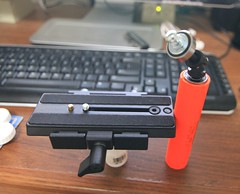Ok, you put your adapter on until you are certain it locks to the lens body. To insert a nikon lens on an f-mount it is with the 'top' at the 3 o-clock position. Then twist counterclockwise to the 12 o-clock when the lock clicks.
To insert the whole assembly to the EOS body, you find the red mark on the adapter, align to the red mark at the 12 o-clock on the body. Twist clockwise until it locks.
To unlock the assembly, push the locking button on the body, twist counter clockwise.
To remove the adapter from the lens, find the tab where the locking pin should be. You should be looking at the rear of the lens. Pull the tab toward you so the locking pin is disengaged. Then twist clockwise if you're facing the rear of the lens.
